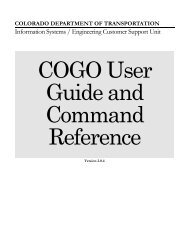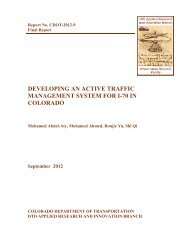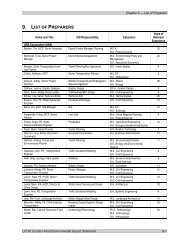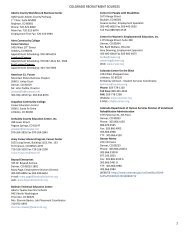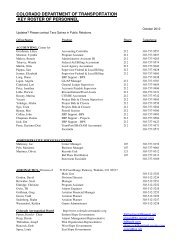Chapter 5 THE AUTOMOBILE AGE BEGINS, 1890-1930 - Colorado ...
Chapter 5 THE AUTOMOBILE AGE BEGINS, 1890-1930 - Colorado ...
Chapter 5 THE AUTOMOBILE AGE BEGINS, 1890-1930 - Colorado ...
You also want an ePaper? Increase the reach of your titles
YUMPU automatically turns print PDFs into web optimized ePapers that Google loves.
section of the state of jealousy of some other section. The belief seemed to<br />
prevail that all the highway commission was after was to put in a few good roads<br />
around Denver” (<strong>Colorado</strong> Highways, April 1929(b): 9).<br />
The commission faced more than apathy and suspicion. Tully recalled that the most<br />
disheartening aspect of their adventure was driving over the same rutted ground covered by the<br />
pioneers’ wagons a half century earlier:<br />
“We traveled 1,600 miles in the state and the motorist today who is not familiar<br />
with the highway conditions of that day has no conception of what we had to<br />
contend with. We found bridges we did not dare to cross in a car, encountered<br />
mud that stuck us, found grades we managed to crawl up at a speed a snail could<br />
beat, and roads that were never meant for anything but a horse-drawn vehicle”<br />
(<strong>Colorado</strong> Highways, April 1929(b): 9)[Figure 4].<br />
Seeing that they had their work cut out for them, the commission moved quickly in their first<br />
year. Tully described in a letter his commission’s expediency regarding road construction to a<br />
colleague in Texas:<br />
“Since the creation of the commission last January we have declared 1,600 miles of state<br />
highway and there is now work underway at fifteen different points in the state by contract and at<br />
three different points in the state by convict labor” (<strong>Colorado</strong> Department of Highways, 1910).<br />
Drawing from their experiences, the commission sent its first annual report (1910) to the<br />
governor filled with recommendations. The commissioners supported the creation of a<br />
permanent Internal Improvement Fund to be used solely for road construction, replacing wooden<br />
bridges with concrete, continued use of convict labor in road work, and installation of uniform,<br />
statewide road signs (<strong>Colorado</strong> State Highway Commission, 1910: 30-1).<br />
Final<br />
CDOT Historic Highway Context<br />
5-19





